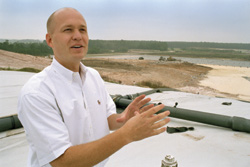| Experiment
Tests New Approach To Landfills
downloadable
pdf
A
massive outdoor experiment is under way to test a new
approach that could significantly extend the lifespan
of the nation’s overburdened landfills and reduce
their potential for pollution.
Workers
on the University of Florida project have spent three
years transforming a 13-acre garbage mound at the New
River Regional Landfill in north Florida into a huge
“bioreactor.” They began pumping liquid
into the garbage last spring, kicking off a decay process
that will be closely monitored with an elaborate and
extensive array of sensors and computer equipment. The
experiment aims to speed up the breakdown of the garbage
dramatically, creating space for more waste and reducing
the threat of contamination of groundwater.
 |
Tim
Townsend, UF associate professor of environmental
engineering, looks over a 13-acre landfill that
has been turned into a bioreactor that is designed
to speed decomposition of trash.
|
Today’s
standard practice is to place garbage in landfills isolated
from the ground by heavy-duty plastic liners. These
liners are intended to intercept toxic leachate —
the liquid that develops as rain percolates through
the waste — from reaching groundwater, said John
Schert, director of the Florida Center for Solid and
Hazardous Waste Management at UF, which is managing
the project.
When
a section of the landfill is full, workers bury the
garbage in dirt to impede vermin and odors. Cut off
from air and a consistent source of water that soaks
all the waste, the garbage often remains preserved for
decades — even centuries, he said.
The
problem is by the time the garbage finally decays, the
liner may no longer hold, allowing leachate to reach
and impact groundwater, said Tim Townsend, a UF associate
professor of environmental engineering and co-leader
of the project with Debra Reinhart, a professor of environmental
engineering at the University of Central Florida.
By
infusing the trash with leachate, water and air, the
bioreactor will spur proliferation of the natural bacteria
that break down garbage, forcing it to decompose in
the first few years when the liner is in the best condition,
Townsend said.
Another
big issue with current landfill technology is that until
it decays, garbage remains bulky, filling space that
could otherwise be used for more waste, Townsend said.
That’s important because new landfills are notoriously
difficult to build because of opposition from residents.
No
new household waste landfill has been built in Florida
since 1994. Yet the amount of garbage collected soared
from 19 million to 25 million tons between 1991 and
2000, and it continues to grow, said Bill Hinkley, chief
of the Florida Department of Environmental Protection’s
Bureau of Solid and Hazardous Waste.
By breaking down garbage quickly, the bioreactor landfill
could reduce the volume of waste in landfills significantly,
making room for more. A main goal of the project is
to figure out just how much compaction will occur. Noting
that some 70 percent of garbage is composed of paper,
food scraps, cardboard and other materials that decompose,
Hinkley estimated the bioreactor could halve the bulk.
“I
don’t think anyone knows the outer limit of what
kind of space could be created,” Hinkley said.
While
bioreacting technology could someday be built into landfills
as they are constructed, researchers on this project
had to convert a conventional landfill into a bioreactor.
The Florida Department of Environmental Protection was
the main sponsor of the project, contributing $5.4 million
in grants since 1998.
Construction
also was extensive. For instance, workers drilled 300
4-inch holes into the landfill, with some reaching nearly
to the bottom of the 70-foot hill. Many of these holes
serve as wells, pumping water as evenly and thoroughly
as possible throughout the garbage.
They
contain packs of temperature, pressure and gas sensors,
which give researchers specific information on how much
decomposition is occurring, where it is occurring, how
much methane and other gas is being produced by the
decomposition process and other data.
“The
plain reality is we continue to landfill the majority
of our solid waste,” Townsend said. “If
we’re going to keep doing that, we need to figure
out better ways to design and operate our landfills.”
John Schert, ujschert@ufl.edu
byAaron
Hoover |


